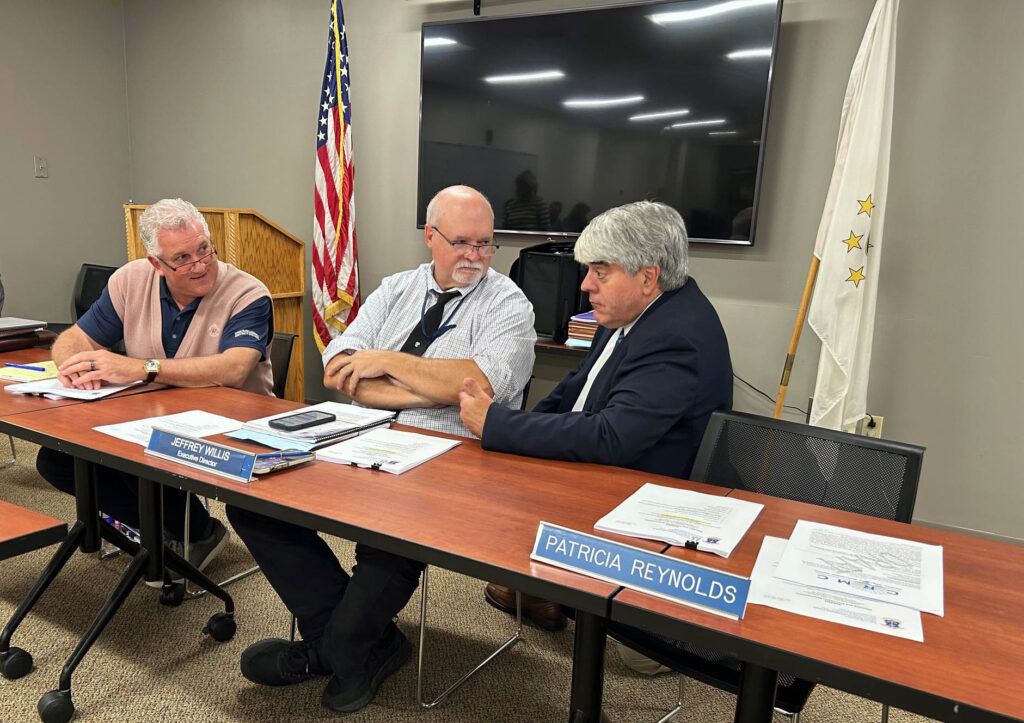From left, Rhode Island Coastal Resources Management Council Chairman Ray Coia; Executive Director Jeff Willis; and attorney Anthony DeSisto confer prior to a council subcommittee meeting on Tuesday, Sept. 24, 2024. (Nancy Lavin/Rhode Island Current)
More than a year has passed since state regulators fined a North Kingstown country club for building a seawall along its property line, without permission and in violation of state coastal regulations.
The 600-foot-long stone wall, built in January 2023, is still standing.
Meanwhile, a parallel but separate consideration of Quidnessett Country Club’s application to ease development restrictions — in turn, potentially, allowing a seawall — remains under review by the Rhode Island Coastal Resources Management Council after a panel punted a recommendation on Tuesday.
The Planning and Procedures Subcommittee’s 4-0 vote will give the country club and its attorney time to make the case for a permanent safeguard between its flagship golf course and the adjacent tidal waters.
“We haven’t seen the evidence yet as to why it’s necessary,” Anthony DeSisto, attorney for the CRMC, said in an interview after the meeting. “We have got to be fair to everyone.”
‘If we get sued’
Also on DeSisto’s mind: the threat of litigation, which has proven a popular route for various parties unhappy with coastal regulators’ decisions.
“If we get sued, we need to make sure there are no appealable issues,” DeSisto said.
The decision to delay a decision came after an hourlong presentation from the council’s coastal policy analysts, who, in a Sept. 20 report, recommended against Quidnessett’s petition to redesignate a section of tidal waters along its northeastern property line.
If approved, the April 12 petition would downgrade the water classification from the existing Type 1 “conservation area” to a less stringent Type 2 “low intensity use,” which could — though it doesn’t have to — allow for a permanent structure like a seawall. Under the existing designation, all permanent structures are banned.
Jennifer Cervenka, attorney for Quidnessett and former CRMC chair, pointed to nearby residential development and recreational use as reasons why the strict conservation designation should be reconsidered.
The staff in its report argued just the opposite, stressing the importance of the sensitive salt marshes surrounding the shoreline, along with marine wildlife, which were the very reason why the agency restricted development there in the first place — formally codified under state water type classifications created in the early 1980s.
“To suggest that shoreline characteristics have changed to the point where there is no longer a balanced relationship between the shoreline characteristics of mainland upland activities and the water type classification is to admit that a party has altered the shoreline’s characteristics in violation of [agency] rules and regulations,” the report stated.
A civil engineering firm hired by the country club backed its argument that a non-permanent structural barrier was insufficient to protect against rising sea levels and weather events. Yet the staff report said the “severe wave action” and shoreline erosion makes the area “particularly unsuitable for structures.”
Council staff also was unpersuaded by country club members’ focus on the golf course’s historic significance. The 18-hole golf course designed by architect Geoffrey Cornish opened in 1960, and is not listed in federal or state historic registers.
The rock wall built over the winter of 2023 by the Quidnessett Country Club in North Kingstown eliminated public access to the water by usurping a passable shoreline to south at left. (Photo by Save the Bay staff)
300 pages of public comments
As for the members-only club’s insistence that it is a key economic support for its employees and the many charities that host fundraisers there? “Anecdotal,” was the staff analysis, adding that a full cost-benefit analysis may be needed if the council considers advancing the club’s request to change the water type.
The 300 pages of written public comments received included a mix of support and opposition. Among the critics: Jim Boyd, former CRMC deputy director; the Rhode Island Office of the Attorney General; and Save the Bay.
Jed Thorp, advocacy coordinator for Save the Bay, said he was disappointed in the lack of a decision Tuesday.
“The facts of the case aren’t going to change,” Thorp said. “The laws and the rules that the staff clearly laid out in the staff report aren’t going to change…. They should have denied the petition today.”
To Thorp, the delay also showcases shortcomings in the agency structure, in which the politically appointed council can — and does — defy recommendations of its expert staff. Save the Bay for years has petitioned state lawmakers to abolish the council and restructure the agency as an administrative authority, akin to the Rhode Island Department of Environmental Management.
The facts of the change aren’t going to change. The laws and the rules that the staff clearly laid out in the report aren’t going to change. They should have denied the petition today.
– Jed Thorp, advocacy coordinator for Save the Bay
“Given the council’s track record of ignoring staff recommendations, it’s unfortunately not surprising,” Thorp said.
Asked to respond to Thorp’s comment, Raymond Coia, CRMC chair, said in an interview after the meeting that the council has not decided against what its staff recommended. It hasn’t made a decision at all.
Cervenka, the country club’s attorney, and its owners, spoke during the July public hearing. But they have not submitted formal evidence, nor presented expert witnesses, Coia said.
The subcommittee is tentatively scheduled to take up this additional information at an October meeting. A subcommittee recommendation, for or against the reclassification petition, still requires final approval from the full, seven-member council.
And if the water reclassification is granted, the club must then apply for a permit to build any kind of permanent structure along the shoreline.
A separate review of the required plan to remove the existing seawall and restore the shoreline remains under review, CRMC Executive Director Jeff Willis said Tuesday.
GET THE MORNING HEADLINES DELIVERED TO YOUR INBOX

